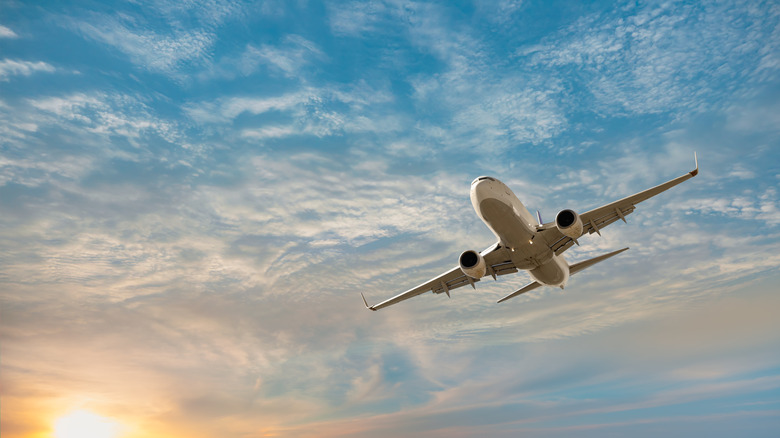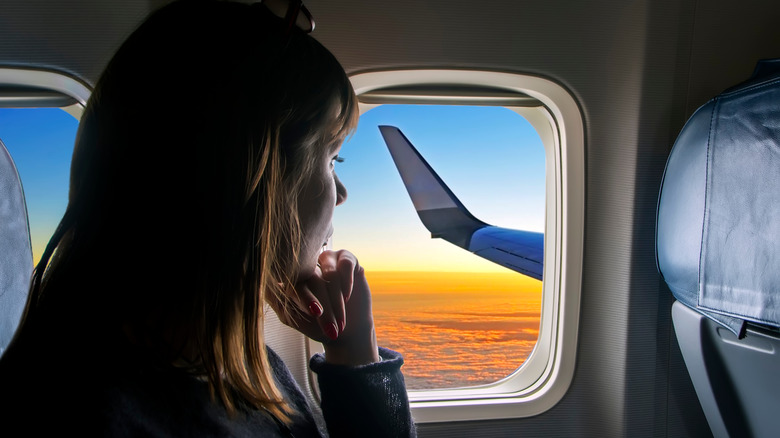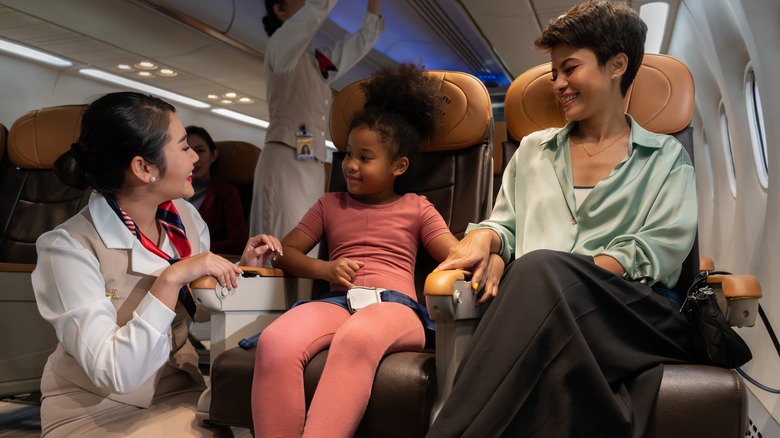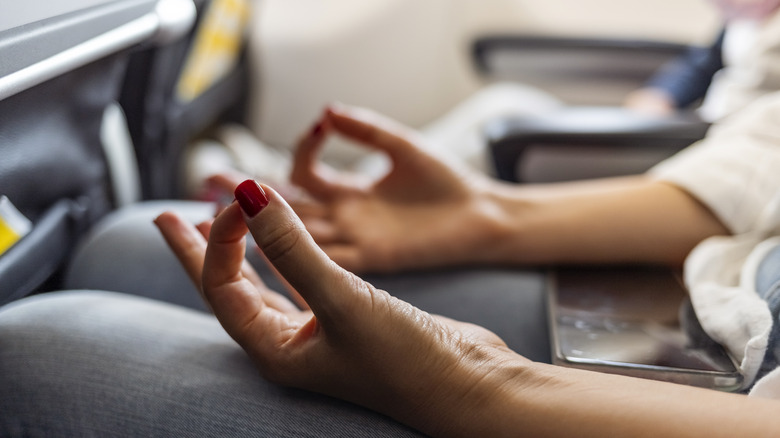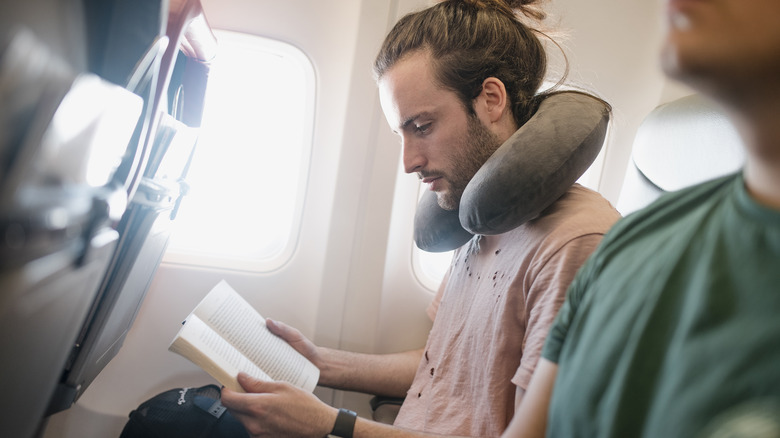Our Best Tips For Coping With Turbulence When You Have Flying Anxiety
Flying anxiety is a lot more common than you think — about 40% of people have some fear of flying, and 2.5% of those individuals have clinical aviophobia. Gliding 600 miles an hour 36,000 feet high in the sky inside a husk of metal, when you think about it, is a formidable human feat. Acknowledging a fear of flying without judgment can be the first step to overcoming it. However, turbulence is an inevitable and uncomfortable part of the flying experience. In this article, we're going to give you our best tips for coping with turbulence when you have flying anxiety.
Turbulence is a regular aviation phenomenon that happens when a plane passes through patches of rough air. It can range from light turbulence, causing minor bumps, to extreme, which is very rare but still manageable. Modern aircraft are rigorously tested and built to endure much more stress than turbulence typically produces. Statistically, the chances of being in an accident due to turbulence are extremely low, and it has never caused a plane crash.
Pilots receive extensive turbulence training. They learn to navigate through areas of rough air and often plan routes to avoid known areas of turbulence when possible. Air traffic controllers and onboard technology assist in identifying and navigating around turbulent zones. Understanding these facts can help demystify the experience and reduce some anxiety. Recognizing turbulence as a routine occurrence and not a safety threat can help shift perception from fear to acceptance. Knowledge is power.
Choose your seat wisely
Choosing your seat wisely is the first step — although they may look it, not all seats are the same. For anyone with flying anxiety, seats over the wings are highly recommended due to their stability; this middle area aligns with the plane's center of gravity, resulting in less noticeable movement. Watching the wings during a flight can even be reassuring for some passengers. The front of the plane, especially in larger aircraft, also offers a smoother experience and allows for quicker exit upon landing.
Aisle or window seat is the age-old question, and the answer is: it depends. If you need to move around, stretch, or just feel less confined, an aisle seat offers more freedom. The open space on one side can reduce feelings of claustrophobia. If looking out helps you feel more at ease, or conversely, if avoiding seeing the outside is better for your anxiety, a window seat provides that control. A wall to lean on can also make resting easier during the flight.
Avoid the back at all costs. The rear of the plane tends to feel more movement, making turbulence especially uncomfortable. Engines and other mechanical noises can be louder at the back, which might add even more to the anxiety. Ultimately, know thyself — your personal comfort preferences are paramount. If you know certain positions or areas in a plane make you extra anxious, avoid them. If you're unsure what works best for you, try different seats on different flights to find your comfort zone.
Inform the flight attendants and familiarize with safety procedures
Informing the flight attendants about your fear of flying takes some vulnerability and honesty, but it's an important step. Flight attendants are trained to deal with all kinds of passenger needs, including anxiety during turbulence. They can provide additional reassurance and check in on you periodically throughout the flight. Their presence can be a reminder that you're not alone in your fears, providing a sense of security and helping you feel more at ease during the journey.
If you're feeling lightheaded, nauseous, or experiencing symptoms of a panic attack during a bout of turbulence, tell the cabin crew. They will do their very best to help you. However, flight attendants are generally not allowed to dispense or administer medication. If you know you tend to experience motion sickness during turbulence, bring Gravol, Benadryl, or other personal medicines in your carry-on so you can take them if necessary. The flight attendant can serve you something to wash it down with or help you skip to the front of the bathroom line if you feel sick.
Familiarizing yourself with the aircraft's safety procedures before and during the flight can significantly alleviate anxiety during turbulence. Make sure to pay attention during announcements made by the cabin crew and pilots — they aren't made for arbitrary reasons. If the seatbelt sign is on, heed the warning and buckle up. Most turbulence-related injuries, averaging only about 33 per year over the past 16 years, happen to passengers not wearing their seatbelts.
Use relaxation techniques
When in turbulence — mind over matter. Mental relaxation techniques are a crucial strategy for managing flying anxiety during turbulence. Deep breathing, meditation, and progressive muscle relaxation can greatly alleviate unpleasant symptoms that can arise, such as sweating, nausea, panic, and more. Deep breathing exercises, like diaphragmatic or belly breathing, involve slow, deep breaths that trigger the body's relaxation response, countering anxiety's typical quick, shallow breathing. Channel your inner yogi and watch the anxiety fade away like the winds that caused the turbulence in the first place.
Simultaneously, focusing on the destination is an effective psychological tool against flying anxiety. If you're feeling the shaky turbulence, instead of envisioning the worst, redirect your thoughts toward the purpose and excitement of your journey instead. Envisioning the fun activities awaiting you, the kind people you'll meet, or the delicious food you'll try provides a powerful mental diversion. This forward-looking mindset, focusing on the journey's rewards, helps manage in-the-moment anxiety and cultivates a more positive outlook.
Various apps designed to combat flying anxiety offer guided meditations (Calm), flight tracking (Flightradar24), plus weather and turbulence updates (Turbulence Forecast), providing reassurance and perspective before and during your flight. Part of this broader strategy is understanding that although it is unsettling, turbulence is less of a big deal than it feels. These combined approaches transform the flying experience from a stressor to an integral aspect of a fulfilling journey. The power of positive thinking is within you!
Distract yourself
You're in-flight, turbulence is happening, you're buckled up, breathing through it — the next best thing to cope with what's going on is distraction. It shifts your focus from the source of stress to something fun and immersive. Bring along a captivating book or e-reader filled with your favorite genres. Create a playlist of your favorite music or download podcasts. Noise-canceling headphones are especially helpful as they drown out the sounds of the plane.
Many flights offer in-flight entertainment, but you can also preload your device with movies or episodes of your favorite shows. This can make time fly (pun intended) and keep your mind occupied. Engaging in puzzles like crosswords, Sudoku, or digital games can be another excellent way to stay busy and distracted from the anxiety that turbulence triggers. Expressing your thoughts through writing or drawing in a journal can also be quite therapeutic. Adult coloring books are a thing for a reason.
Or, something a little more old-fashioned, talk to your seat neighbor. Maybe it's someone you know, or even if it's someone you don't know — a light conversation can help distract both of you from the rattle and stress of turbulence. Switching between reading, chatting with a friendly seatmate, and other tasks can keep boredom at bay. Having a variety of activities can keep things interesting, especially on longer flights. Ensure that your entertainment is prepared before your takeoff — charge your devices, download whatever content you like, and pack any physical items like books or journals in your carry-on.
Consider counselling, medication, or support groups
If coping with turbulence and flying anxiety is a pervasive issue, professional help is available. Counseling offers a safe space to explore and understand your fears, equipping you with long-term strategies. Cognitive-Behavioral Therapy (CBT) focuses on identifying and changing negative thought patterns and can be highly effective. A therapist can tailor techniques to your specific case, ensuring that you're addressing the root cause of your anxiety. Exposure Therapy, often used alongside CBT, involves gradual exposure in a controlled environment, such as a flight simulator, helping to reduce anxiety over time.
Medication can also help in times of turbulence, but it should always be used under the guidance of a healthcare professional. Anti-anxiety medications or sedatives can provide some temporary relief. However, they are not a long-term solution and can sometimes hinder the process of learning to cope with turbulence anxiety naturally. Medication can be part of a broader strategy, including counseling and relaxation techniques, allowing you to practice a holistic approach to managing your fear.
Support groups can provide further empowerment. These groups provide a platform, whether online or in-person, by bringing together individuals to share experiences, coping strategies, and encouragement surrounding anxiety about flying. Hearing how others manage their fear can be inspiring and provide practical tips that might work for you. These groups offer a sense of community that can be hard to find elsewhere. Armed with these coping strategies, your next flight will be a smoother journey, not just in the skies (no matter how turbulent!), but within yourself.
